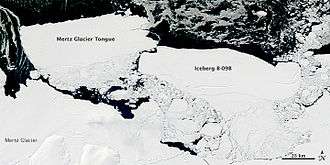Iceberg B-9
Coordinates: 66°36′0″S 142°36′0″E / 66.60000°S 142.60000°E

Iceberg B-9 was an iceberg that calved in 1987.[1] The iceberg measured 154 kilometres (96 mi) long and 35 kilometres (22 mi) wide with a total area of 5,390 square kilometres (2,080 sq mi).[1] It is one of the longest icebergs ever recorded.[1] The calving took place immediately east of the calving site of Iceberg B-15 and carried away Little America V.[1]
Starting in October 1987, Iceberg B-9 drifted for 22 months and covered 2,000 kilometres (1,200 mi) on its journey.[1] Initially, B-9 moved northwest for seven months before being drawn southward by a subsurface current that eventually led to its colliding with the Ross Ice Shelf in August 1988.[1] It then made a 100-kilometre (62 mi) radius gyre before continuing its northwest drift. B-9 moved at an average speed of 2.5 kilometres (1.6 mi) per day over the continental shelf, as measured by NOAA-10 and DMSP satellite positions, and the ARGOS data buoy positions.[1] In early August 1989, B-9 broke into three large pieces north of Cape Adare.[1] These pieces were B-9A, 56 by 35 kilometres (35 mi × 22 mi), B-9B, 100 by 35 kilometres (62 mi × 22 mi), and B-9C, 28 by 13 kilometres (17.4 mi × 8.1 mi).
B-9B drifted toward the Mertz Glacier on the George V Coast, where it came to rest next to the glacier and remained there for eighteen years. On February 12 or 13th 2010, Iceberg B-9B collided with the giant floating Mertz Glacier tongue and shaved off a new iceberg that measured 78 kilometres (48 mi) long and 39 kilometres (24 mi) wide.[2] The two icebergs then began drifting together about 100–150 kilometres (62–93 mi) off the eastern coast of Antarctica.[2]
By December 2011, Iceberg B-9B had made its way into Commonwealth Bay and had broken up into three major pieces, parts of which were frozen to the seabed.[3] The huge iceberg prevented three tourist ships from reaching Antarctica to mark the centenary of the polar voyage of Australian explorer Douglas Mawson, who landed at Cape Denison on January 8, 1912 and constructed a complex of huts that remain standing to this day.[3] The three tourist ships attempted to reach the cape but had to turn back due to unusually harsh conditions caused by B-9B's position in the bay. A spokeswoman from the Australian government's Antarctic division observed, "There [are] unusual ice conditions ... affecting all the tourist ships that are going down there because the tourist ships don't have ice-breaking capabilities, and they also don't have choppers, so their ability to get anywhere near the Mawson's huts area is basically stopped."[3] Iceberg B-9B could remain in Commonwealth Bay for the next decade.[3]
See also
References
- 1 2 3 4 5 6 7 8 Keys, Harry; Jacobs, S.S.; Barnett, Don (11 June 1990). "The calving and drift of iceberg B-9 in the Ross Sea, Antarctica". Antarctic Science. 2 (3): 243–257. doi:10.1017/s0954102090000335. Retrieved 23 February 2014.
- 1 2 "B9B iceberg the size of Luxembourg strikes Antarctica". Daily News. 26 February 2010. Retrieved 23 February 2014.
- 1 2 3 4 Coopes, Amy (22 December 2011). "Huge iceberg foils Mawson centenary plans". Cosmos. Archived from the original on February 28, 2014. Retrieved 23 February 2014.